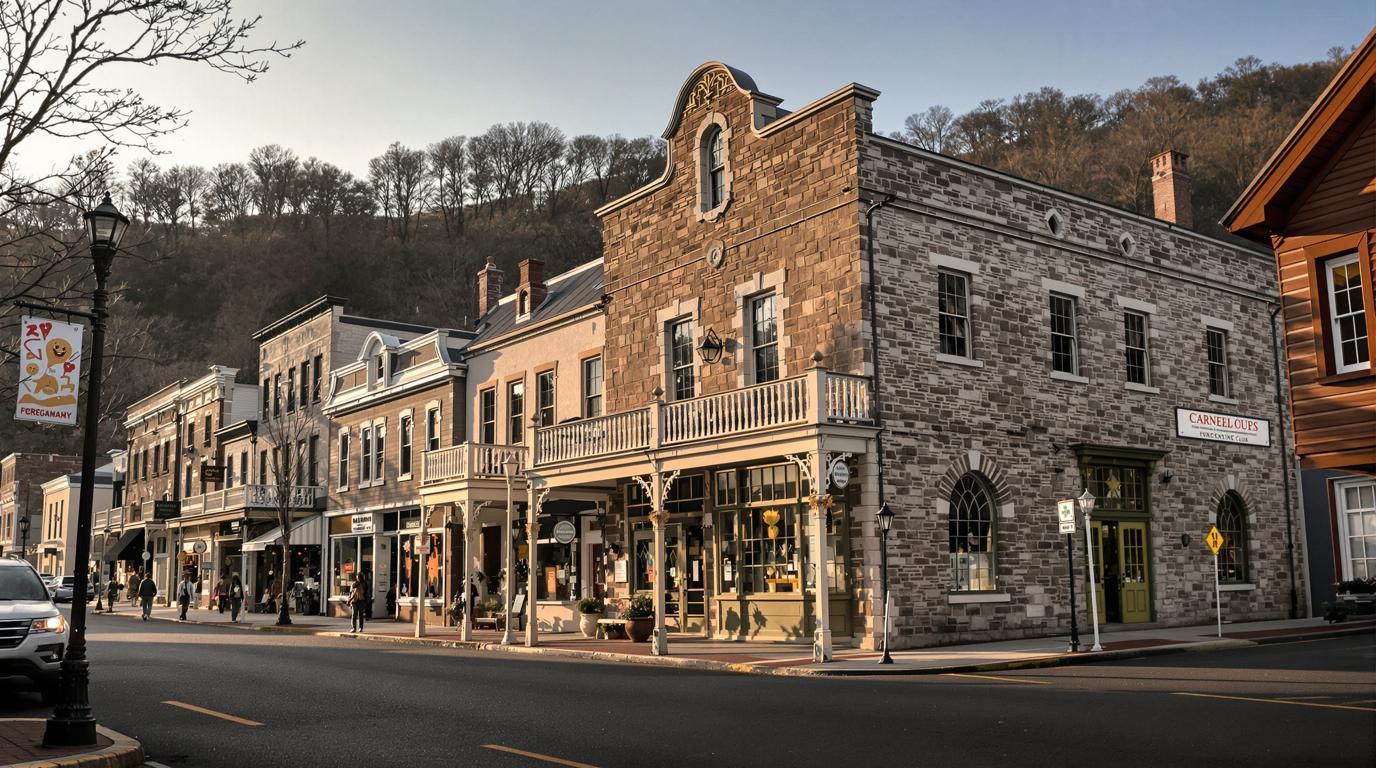The limestone walls of downtown Lewisburg rose before me like a forgotten stage set, their Federal-era facades catching the morning light in ways that reminded me of Staunton’s theater district—except here, at 2,080 feet elevation, the July air felt surprisingly cool against my skin. After fifteen years of chasing authentic American destinations, I’d stumbled upon this 3,930-resident Appalachian sanctuary that guards one of the Civil War’s most accessible yet overlooked battlefields. What struck me wasn’t just the preserved 19th-century architecture or the 70+ buildings on the National Register—it was how this West Virginia gem delivers everything you’d expect from Virginia’s historic towns, but with mountain air that stays 15°F cooler and crowds that never materialize.
Most travelers racing between Charleston and Virginia Beach never pause in Greenbrier County, missing what locals quietly call “America’s Coolest Small Town.” Standing on Washington Street, watching families stroll past hand-forged ironwork and original stained glass windows, I realized this place offers something increasingly rare: authentic historic immersion without the tourist circus that’s consumed places like Williamsburg.
The discovery happened by accident, as the best travel finds often do. I’d been researching Civil War sites off the beaten path when a local historian mentioned the Battle of Lewisburg—a May 23, 1862 engagement where Union forces routed Confederate troops right through these very streets. Unlike Virginia’s crowded battlefields, you can actually walk the battle route undisturbed, following bronze markers that tell the story of makeshift hospitals set up in downtown churches.
The Civil War secret that Virginia’s crowded battlefields can’t match
Where history unfolds without the crowds
The Battle of Lewisburg site at 115 Church Street reveals something extraordinary: Civil War history you can actually touch and explore without fighting tour groups. The preserved structures that served as Confederate field hospitals still stand, their limestone walls bearing witness to a engagement that shaped the Greenbrier Valley’s fate. What makes this special isn’t just the accessibility—it’s the authentic scale where you can visualize the entire battle unfolding across a walkable downtown grid.
The underground Civil War fortress tourists never find
Twenty minutes from downtown, Organ Cave holds America’s largest collection of Civil War-era saltpeter hoppers, the wooden contraptions Confederate forces used to mine gunpowder ingredients in the nation’s biggest cavern system. Unlike overcrowded Virginia sites where you’re shuffled through gift shops, here you can explore subterranean passageways where Confederate soldiers actually worked, their tools and mining equipment preserved exactly as they left them in 1862.
The architectural authenticity that rivals Staunton’s theater district
Federal-era facades that tell America’s story
Walking Lewisburg’s compact downtown feels like stepping into a perfectly preserved 19th-century American town, where Federal, Greek Revival, and Victorian architecture creates an unbroken historical narrative. The hand-forged ironwork and original storefronts survived because this place never experienced the urban renewal that gutted so many similar towns. Unlike heavily restored historic districts elsewhere, Lewisburg’s authenticity comes from continuous inhabitation rather than museum-style preservation.
The limestone legacy that defines Appalachian architecture
The local limestone that built these structures tells the story of Appalachian karst geology, where underground rivers carved the caves that provided both building material and Civil War hideouts. This isn’t just pretty architecture—it’s functional beauty born from the land itself, creating a visual coherence that feels organic rather than planned.
The elevation advantage that beats Virginia’s summer heat
Mountain air that transforms summer travel
At 2,080 feet, Lewisburg sits in that sweet spot where Appalachian elevation creates natural air conditioning without the extreme remoteness of higher mountain towns. While Virginia’s Tidewater region swelters in July humidity, this mountain sanctuary maintains comfortable temperatures that make walking tours pleasant even at midday. The cooling effect rivals expensive mountain resorts but without the crowds or inflated prices.
The seasonal timing that locals keep secret
Summer visitors discover what residents have always known: Lewisburg’s elevation creates perfect conditions for exploring historic sites during peak travel season. The limestone buildings stay cool, the tree-lined streets provide natural shade, and the mountain air makes evening strolls through the historic district genuinely refreshing rather than an endurance test.
Travel Note: I’ve explored historic towns across five continents, but Lewisburg’s combination of authentic preservation, comfortable climate, and accessible Civil War history creates something uniquely American—a place where you can experience our nation’s past without the commercial overlay that’s transformed so many similar destinations.
Frequently Asked Questions
How does Lewisburg’s summer weather compare to Virginia’s historic towns?
Lewisburg’s 2,080-foot elevation typically keeps summer temperatures 10-15°F cooler than lowland Virginia destinations like Williamsburg or Richmond, making July and August ideal for walking tours and outdoor exploration.
What makes Lewisburg’s Civil War sites different from Virginia’s battlefields?
Unlike Virginia’s crowded battlefields, Lewisburg’s Civil War sites offer intimate, uncrowded access to authentic locations where you can actually walk the battle route through downtown streets and explore underground Confederate operations in nearby Organ Cave.
How accessible is Lewisburg from major cities?
Lewisburg sits along I-64, making it easily accessible from Charleston, WV (90 minutes), Richmond, VA (3 hours), and Washington, DC (4 hours), yet it maintains the authentic small-town character that makes it feel worlds away from urban congestion.
What’s the best time to visit for optimal weather and fewer crowds?
July through September offers the perfect combination of comfortable mountain weather and manageable visitor numbers, with August being especially ideal for exploring both downtown historic sites and the cool underground chambers of Organ Cave.
Standing on Washington Street as the evening mountain air carried the scent of limestone and history, I understood why this 3,930-resident sanctuary has remained largely undiscovered—it offers everything travelers seek in Virginia’s historic towns but with the authentic pace and cooling elevation that makes exploration genuinely enjoyable. In a world where authentic American destinations are increasingly rare, Lewisburg represents something precious: a place where history lives and breathes without the commercial overlay that’s transformed so many similar towns into tourist attractions rather than living communities.
